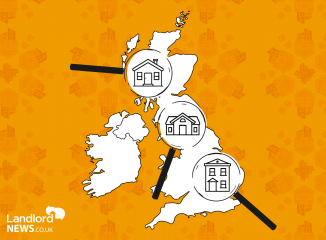The latest government UK House Price Index reports that average house prices have increased by 8.9% over the year to April 2021. This is down from 9.9% in March 2021.
The highlights of the report also include:
- The average price of a UK property in April 2021 was £250,772
- At the country level, the largest annual house price growth in the year to April 2021 was recorded in Wales, where house prices increased by 15.6%
- Scotland saw house prices increase by 6.3% in the year to April 2021
- England saw house prices increase by 8.9% in the year to April 2021
- Northern Ireland saw house prices increase by 6.0% over the year to Q1 (January to March) 2021
Ged McPartlin, Managing Director of Ascend Properties, comments: “Despite a cooling in the monthly rate of house price growth the northern property powerhouse continues to steam ahead, registering some extremely impressive gains on an annual basis.
“This should continue for the remainder of the year, albeit at a less ferocious rate once a Stamp Duty saving is no longer on the cards, as buyers continue to take advantage of low mortgage rates and the newly available 95% mortgage.”
James Forrester, Managing Director of Barrows and Forrester, comments: “There’s no doubt that this monthly decline in house price growth is the markets lagged response to the original Stamp Duty deadline, as buyers and sellers renegotiated terms under the impression a saving was no longer on the table.
“However, it’s far from the market cliff edge that many naysayers had predicted and so it’s fair to say we can put any fears of a market crash in the wake of the extended deadlines to bed.”
Marc von Grundherr, Director of Benham and Reeves, comments: “London has been slowly simmering in comparison to the rest of the UK market having been hit hardest by pandemic uncertainty and a reduction in foreign homebuyer demand, in particular.
“However, the tide is slowly starting to turn and while there’s a very real chance that the wider UK market will come off the boil by the end of the year, London will continue to bubble.”
Matthew Cooper, Founder & Managing Director of Yes Homebuyers, comments: “Almost a full house of regional monthly house price declines in the wake of the original Stamp Duty holiday deadline gives a good indication of what awaits the market at the backend of this year.
“A correction is on the way and we can expect to see a weary market start to show signs of house price fatigue as early as next month, following the initial wind down of the Stamp Duty holiday.”
Andy Sommerville, Director at Search Acumen, comments: “This latest data indicates the new build premium shows no signs of abating.
“This is despite the monthly drop off, which is likely due to an inflation of March’s growth as people rushed to meet the first anticipated Stamp Duty deadline. Demand in April continued to outstrip the availability of housing stock, contributing to one of the biggest gaps seen in years between the price of new builds and existing properties.
“Our national housing supply squeeze looks set to continue for the foreseeable future, pushing up prices further still. The beneficiaries on the building side are the developers of homes with access to gardens, given that working from home and more flexible working practices are likely to continue in the coming months, driving people to move into bigger homes with access to green space.
“The Stamp Duty stampede is piling pressure onto property professionals who are charged with helping new buyers access homes as quickly as possible. Too often, lawyers are seen as those slowing down the moving process, but many are handicapped by legacy practices that weren’t designed for current volumes of demand or with modern consumer needs in mind. Data can provide an antidote to smooth transaction processes, so lawyers can better advise prospective buyers on the risks involved in their purchase at an earlier stage and clear the path towards completion.”
Nicky Stevenson, Managing Director at national estate agent group Fine & Country, comments: “If there’s anything that underlines changing property shopping habits, it’s the eye-watering growth rate recorded in the North East. It has eclipsed all regions bar Wales, which is another favourite destination for those escaping to the country. A leap of 16.9% in 12 months is staggering.
“By next year we’ll be looking back at a figure like this with some awe but the way the market cools from this point doesn’t have to match the rally for excitement.
“If the government’s financial support packages have worked, and employment prospects remain strong, then a gentle long tail that avoids outright falls in prices over the medium term is still likely as we head towards the end of the year and into 2022.
“It’s worth noting that the annual growth readout for the previous month of March has also been revised down, which means it didn’t actually exceed the psychologically important 10% level after all. That said, the market is still overheating, despite a slight softening in the shadow of the original Stamp Duty holiday deadline.”
Lucy Pendleton, property expert at independent estate agents James Pendleton, comments: “We’re getting so used to growth rates this high that it’s easy to forget that they are actually as rare as hen’s teeth. First-time buyers will be hoping this star fades fast, and fade it must because the market is punching the top of the dial by historic standards.
“A dose of economic reality is going to start featuring in our lives over the next few months in a way that has been largely absent since early last year. The patient is going to be slowly weaned off the government support that has masked the brutal ructions that would otherwise have played havoc with jobs, house prices and the economy.
“That all begins at the end of the month with the tapering of not just Stamp Duty relief but the furlough scheme too. As it becomes clear how bullet proof the jobs market really is, we’ll get a better understanding of how the economy — on the cusp of fully unlocking — will endure this return to fiscal normality.
“London remains at the back of the pack but started from a higher base and could yet surprise with relatively strong growth as people start returning to the capital in greater numbers. London is likely to be more immune from any slowdown in growth later this year, as it hasn’t been performing the same kinds of heroics seen in other regions.”





